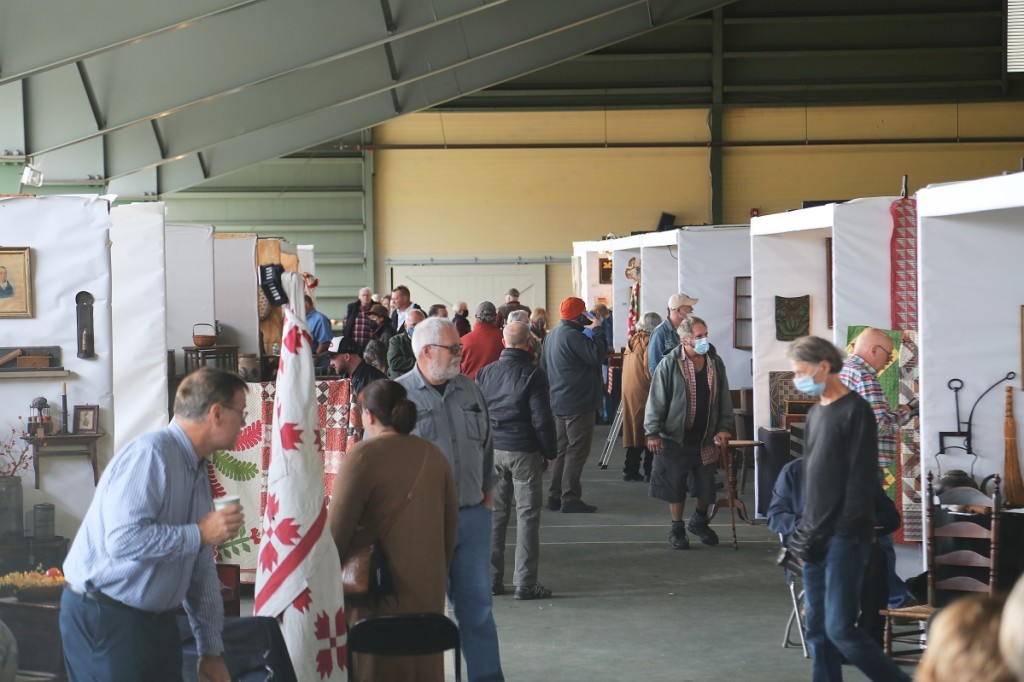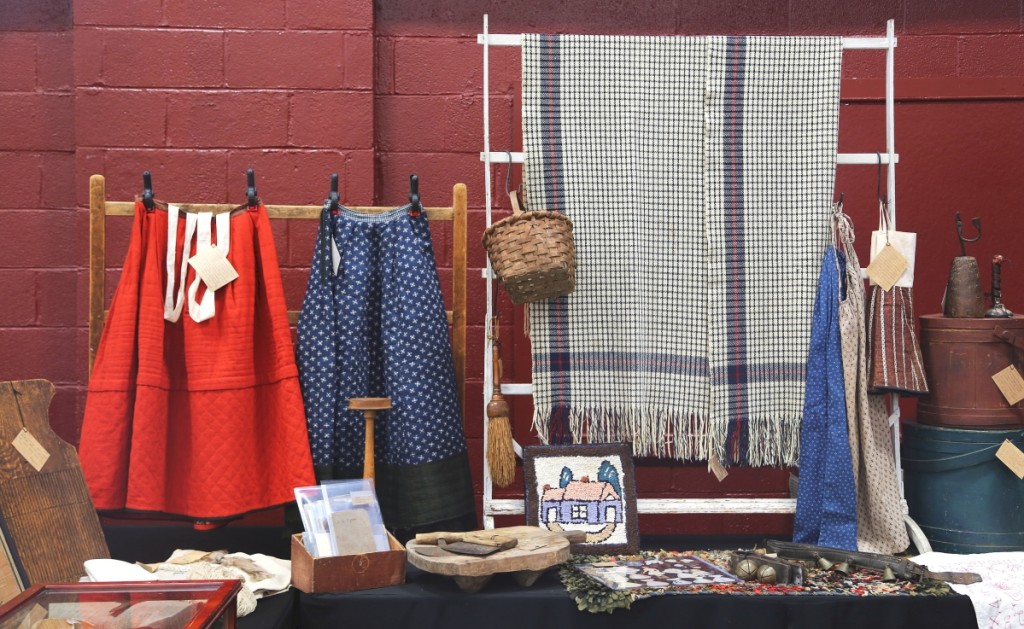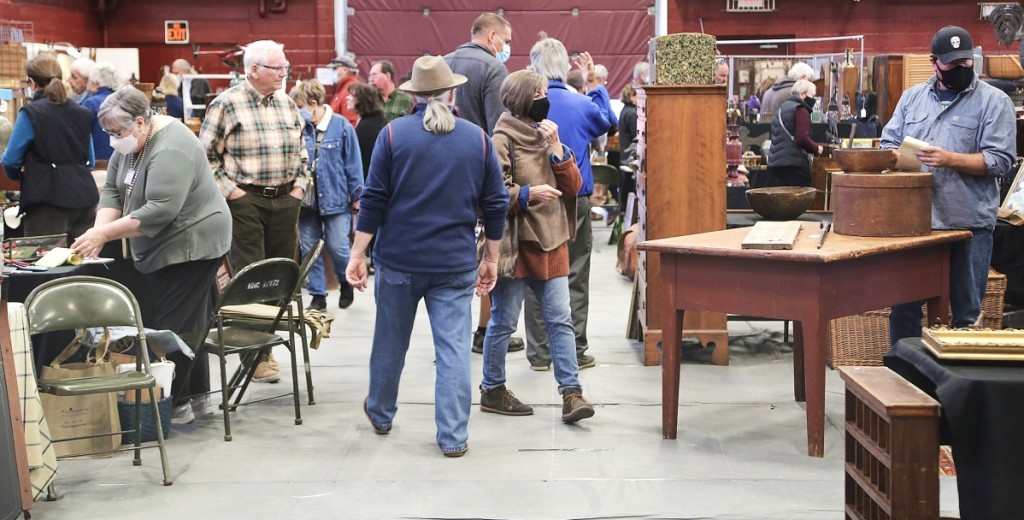Review and Photos by Greg Smith
LUDLOW, VT. – When we spoke with show manager Steve Sherhag after last year’s edition of Vermont Antiques Week, he had just settled the books and was breathing a sigh of relief. It was difficult to pull that event off in the town of Ludlow – frankly, any town in America at that moment – and he and his brother, Bill Sherhag, had overcome the hurdles of local bureaucracy, militant neighbors and a new, untested venue location to organize a fun event that included two shows under tents tucked into the valleys of ski-country Vermont.
“Next year will be easier,” he said, but each year brings different challenges. There is likely no one who believes more in the potential of this antiques week than the Sherhags. For the second year in a row, they were the only organizers to stage an event under its umbrella, or two as it were.
When the Vermont Antiques Dealers’ Association dissolved in July 2021, so too did its annual show at Stratton Mountain that fell under the week’s umbrella. And for the second time in a row, the Weston Community Association, which puts on the Weston Antiques Show, cancelled on account of Covid-19 concerns.
The Sherhags’ shows were the only two left standing: the Black River Antique Show, which graced the Ludlow Community Center October 1-2, and Antiques at the Icehouse, their newly rebranded show that moved into the open-air Ice House skating rink pavilion at Jackson Gore Lodge of Okemo from October 2-3.
While it may have changed a few things for the sellers and their manager, it was business as usual for buyers. When the leaves start turning, New England aesthetes know that there is only one place to go hunting for quality Americana, and that’s in Vermont.
The Black River Antique Show
Twenty-five dealers made up the Black River Antique Show this year and they spread evenly throughout the gymnasium at the Ludlow Community Center. The only thing missing from the show was the Friday night dinner and the snacks, which help to support the Community Center’s programming. Covid protocols put the food on hold this year.
The tabletop show served as the weekend’s starter course and it was alive and well as the gate opened to the long line of buyers that had gathered outside.
The event received some of the dealers who normally did other shows that week.
When asked how selling went the morning after the show’s first day, Pike, N.H., dealer John Steenburgh said, “It went really well. I sold five pieces of furniture, most of the trenchers, tons of smalls… It was great.”
The trenchers were from Steenburgh’s personal collection, their exodus the result of remodeling at his home. “We just redid our kitchen and Mary said they had to go,” he said, referring to his wife. Josh said they had mostly come from homes around his way.
Antrim, N.H., dealer Stephen Burkhardt brought one of the first antiques he had ever bought. In 1989, before he owned a home, Burkhardt acquired a 6-foot-high cupboard that he believes is from Pennsylvania. “They’re usually a little larger than that,” he said. Behind it was a fine Star of David quilt.
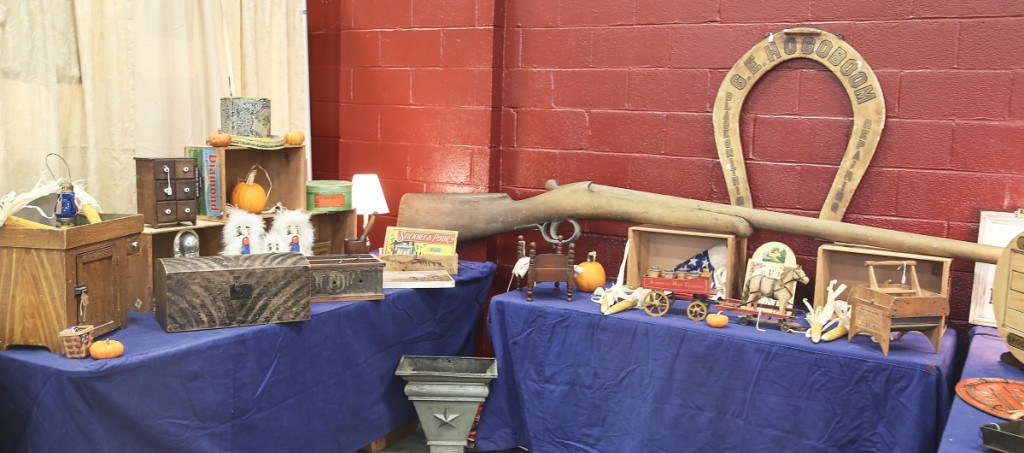
Prospect Hill Antiques of Essex Junction, Vt., brought a monumental carved wood trade sign in the form of a single barrel shotgun or rifle. —Black River Antique Show
Another quilt was on show with Christopher Nolan of Albany, N.Y. The Lone Star quilt, so named for the single star that spans its length, was once in the collection of a Texas museum. Nolan had a fine grain painted chest of drawers in his booth and sold a corner cupboard early on.
Common sense dictates you don’t bring a sign to a gunfight, but what if the sign was a gun about 10 feet long? On offer with Prospect Hill Antiques of Essex Junction, Vt., the dealership of Peter and Kathy Hunt, was a monumental carved wood sign in the form of a single barrel shotgun or rifle. Peter said he found the gold-painted sign in southern Vermont and it was similar to an example at the Shelburne Museum.
With Park Antiques, Rutland, Vt., was a nice slice of Americana. The dealer featured a provocative carved and painted bust of a woman, a number of cobalt-decorated pieces from the Ottman Bros pottery of Fort Edward, N.Y., trade signs and an unusual lacquered Suprematist-style cutlery box from the International Silver Co.
Vintage textiles were represented from Sandy Elliott Country Antiques of Brentwood, N.H. Among her offering was a selection of petticoats, including a red wool adult example from Nineteenth Century Pennsylvania. From the same period was a child’s dress in brown and red calico.
A collection of shoes was on exhibit with Robin Stephens of Richmond, Mass. We’re not talking about Tory Burch, Louboutin or Prada, but rather shoes cut from wood to become signs or canisters. Stephens said she bought the collection whole from a New York state collector who, interestingly, had no interest in the Tory Burch-, Louboutin- or Prada-style shoes, either.
Sherhag said that the Community Center still finds ways to benefit via porters and coffee sales and a contribution from the show. The long-held event plans to be back in its same spot next year, hopefully with dinner for the Friday night attendees.
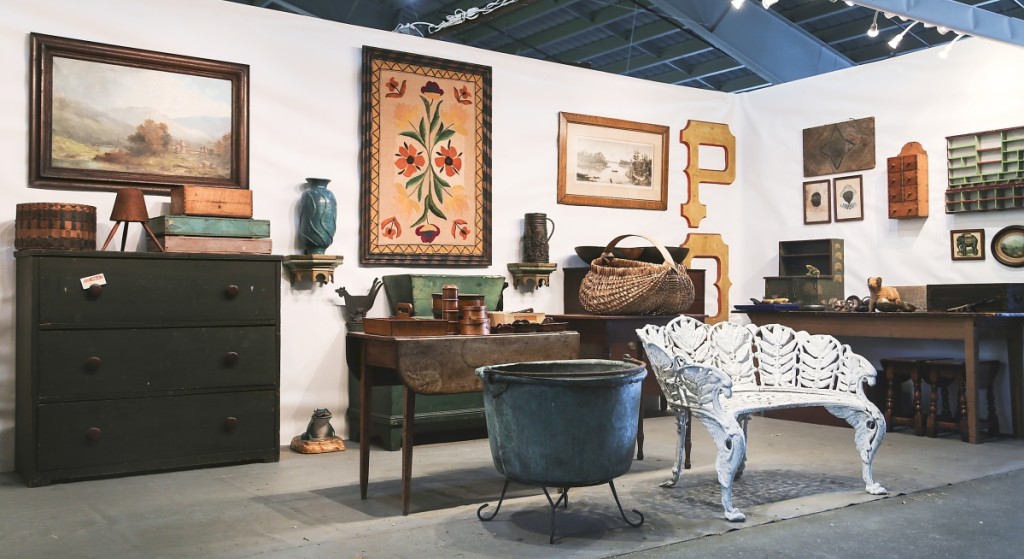
At center is a vibrant stitched floral picture with a hand painted frame. Village Braider, Plymouth, Mass. The dealer also had an attractive pair of large building stars (not pictured), typically used to secure masonry facades to a building, that had been fashioned into andirons. —Antiques at the Icehouse
Antiques at the Icehouse
It had a new name, but the show floor at Antiques at the Icehouse carried on a tradition of Okemo lodge shows that gather quality Americana in great quantity. The event that was previously known as the Okemo Antiques Show – and which found itself on the grounds of nearby Fletcher Field last year – looked good. Antiques at the Icehouse took its name from its new venue – the Ice House – a skating rink below the Jackson Gore Lodge of the Okemo Mountain Resort. The structure is an open-air, roofed pavilion that seemed tailor-made for an antiques show held in a pandemic. If you could get a room at the nearby Jackson Gore Lodge (disclaimer: I could not – book earlier!) all that was left was to walk on down.
While the show attracts dealers in general Americana, it also has its hot spots. The unsurprising highlight would be Vermont material: Shaftsbury painted furniture, metalware made by Vermontian blacksmiths and folk paintings by itinerant artists traveling through the Green Mountain State. More surprising is that the show is one of the great displays of primitives in the east. Buyers of that material had a buffet to choose from, offered from a glut of fine specialist dealers.
Among those Green Mountain itinerant artists was Thomas Ware, represented by a portrait of a boy in the booth of Massachusetts dealer Antiques Associates at West Townsend. Born in 1803, Ware was plying his trade for a half decade before he died in his twenties. Still, Arthur & Sybil Kern were able to count 41 works for an article in the 1983 winter edition of Harvard’s The Clarion and more have likely come to light since. With the dealer, Ware’s portrait features the boy in a typical dark background with rosy cheeks and ruffled sleeves. “That’s about as Vermont as you get,” dealer David Hillier said.
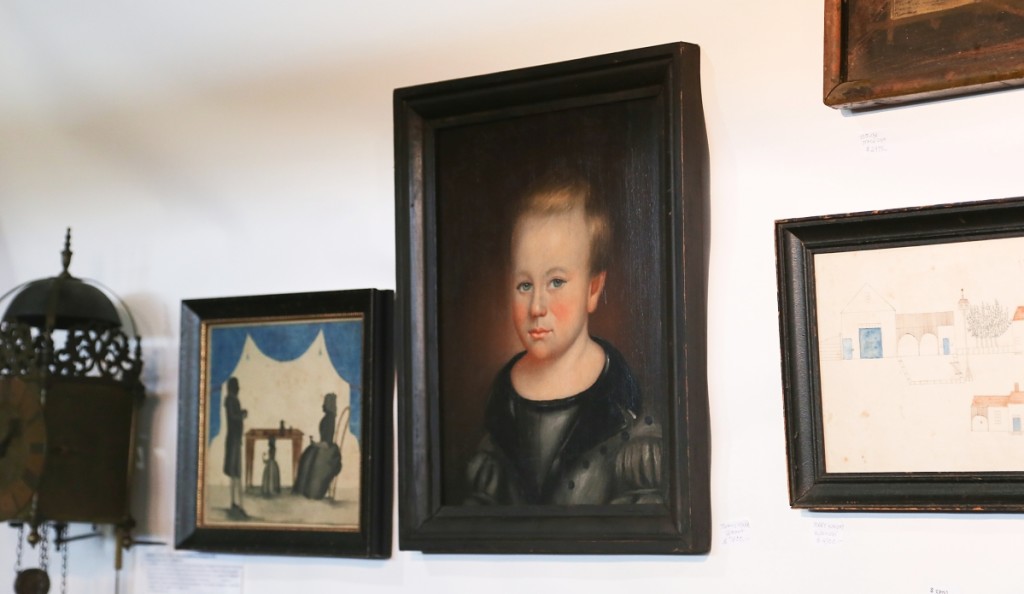
Itinerant Vermont folk artist Thomas Ware painted this portrait of a young boy. It was with Antiques Associates at West Townsend, West Townsend, Mass. —Antiques at the Icehouse
While the Kerns are in play, J.S. Cocoman Antiques of Glenmont, N.Y., featured an 1836 folk portrait of a man with quill pen by Asahel Powers (1813-1843). Powers was another Vermont folk artist who died young at age 30. The portrait had been in the Kerns’ collection and had provenance to Fred Haight. It was featured in Nina Fletcher Little’s 1973 Asahel Powers: Painter Of Vermont Faces, where the curator wrote, “The portrait is one of the artist’s most penetrating likenesses, almost photographic in its portrayal of character.”
There were some fabulous boxes on the show floor. Limington, Maine, dealer Bill Kelly featured a wonderful small dome top example from Vermont with a white ground and squiggle embellishments in red and blue throughout. Searsport, Maine dealers Dennis Raleigh and Pumpkin Patch Antiques brought a fine reeded and checkerboard box in blue and red that they believed was from New York state. Also from that area was a paint-decorated black basswood dome top box from the Nineteenth Century with Ponzi’s Antiques, Trumansburg, N.Y. The box’s fine floral decoration flourished within two bands on opposite ends that extended from the sides of the front to the top and back. If tin was more your style, a box in great, original condition was on show with Brendan Edgerton of Country Cupboard Antiques, Portsmouth, N.H. The Nineteenth Century tin deed box was in original Prussian blue with oyster white and red decorations. Edgerton said it was from New England, possibly Connecticut, and dated to circa 1830.
If you were decorating with primitives, there were many to choose from. An early sale from Connecticut dealers Paul and Karen Wendhiser came in the form of a wide cheese basket. Over with Mary de Buhr of Downers Grove, Ill., the dealer featured wood fragments and pine furniture. With her was a Nineteenth Century pine cupboard with open shelves behind the hinged door that had just come from a Vermont collection. She also featured a paneled fireplace surround taken out of a 1783 Gilmanton, N.H., home. Primitives of equal quality were on exhibit with Ivy Hill Primitives and Mathew Ehresman Antiques.
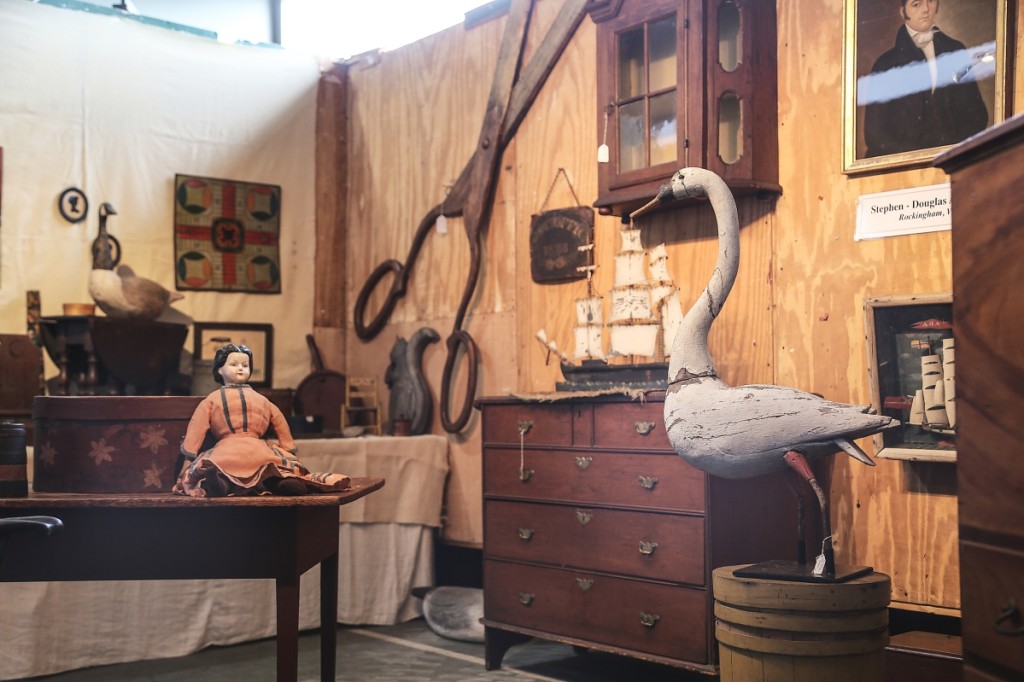
A fine swan decoy lured buyers into the booth of Stephen-Douglas Antiques, Rockingham, Vt. The dealers hosted a concurrent open house in their nearby Walpole, N.H., gallery and said the show at Okemo looked the best it has in years. —Antiques at the Icehouse
With Erik D. Wohl, Jupiter, Fla., came a pair of Vermont cream barrels in an octagonal form. The barrels were marked for Moseley and Stoddard of Poultney, Vt., and dated to 1860.
The show was practically in the backyard of Rockingham, Vt., dealers Stephen-Douglas Antiques, and Stephen Corrigan and Doug Jackman planned an open house to coincide with the week. Corrigan had only good things to say: “I thought the Ice House was probably the best looking show in a long time – boy I saw some good stuff there. Better quality than I’ve seen in a while. I sold a few expensive things, and also some inexpensive things. It was set up and spread out nicely.”
Among his sales he counted a fine Vermont decorated hat box or bride’s box with freehand decoration. It had newspaper from Lyndon, Vt., up in the Northeast Kingdom of the state. He said it was unusual to find material from that corner of Vermont and it sold to a buyer new to him.
His open house also proved fruitful and Corrigan hopes more people will travel up to Vermont next October to see this diamond-in-the-making.
Take it from us, it’s worth the trip.
For additional information, www.vermontantiquesweek.com.

